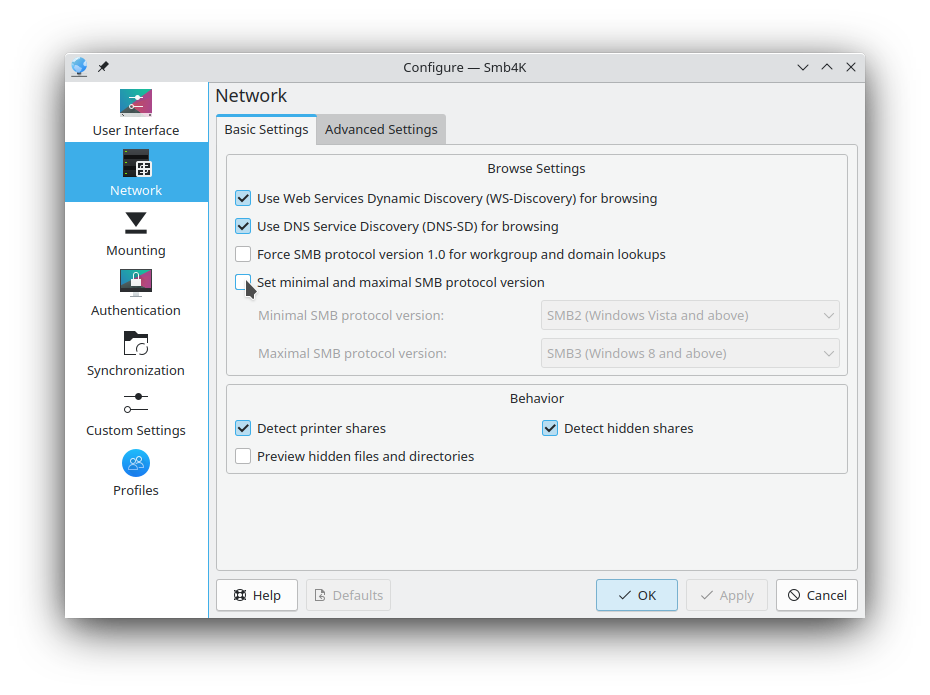The options located here influence the network communication. You can modify the browsing and display behavior in the tab and the more advanced options for Samba and the Wake-On-LAN capabilities in the tab.

The Web Services Dynamic Discovery (WS-Discovery) protocol is used to browse the local network and discover workgroups, domains and hosts. This is useful if your network neighborhood is dominated by servers with modern Windows® versions. If you use this option, there should be no need to force Samba's client library to use the SMB protocol version 1.0 to search for workgroups and domains.
Note
This setting is optional, and only appears if you compiled Smb4K with WS-Discovery support.
Default: selected
The DNS Service Discovery (DNS-SD) interface is used to browse the local network and discover servers that provide shared SMB resources. The discovered domains correspond to the local DNS domains (e.g., named LOCAL) and most likely not the ones defined in the network neighborhood. However, this does not influence the browsing. If you use this option, there is no need to force Samba's client library to use the SMB protocol version 1.0 when searching for workgroups and domains.
Default: selected
Select this option as a last resort, because the SMB protocol version 1.0 is unsafe and has been disabled in newer Samba and Windows® versions. However, if you have trouble discovering workgroups and domains in your network neighborhood, you might want to consider switching this setting on. If you are using DNS Service Discovery (DNS-SD) or Web Services Dynamic Discovery (WS-Discovery), and those are working for you, you do not need version 1.0.
Default: not selected
Set the minimal and maximal SMB protocol version that is used by Samba's client library to browse the network neighborhood. This will override the settings in the smb.conf file. Normally, you do not need to use this option, because the right protocol versions should be negotiated between the client and the server while establishing a connection. Please note that this setting might not be appropriate to make the discovery of workgroups and domains work while keeping undisturbed connectivity to servers. Use DNS Service Discovery (DNS-SD) or Web Services Dynamic Discovery (WS-Discovery) for domain and workgroup lookups instead.
The settings below for the minimal and maximal SMB protocol version are enabled by checking this checkbox.
The maximal SMB protocol version must be equal to or greater than the minimal SMB protocol version.
Default: not selected
- Minimal SMB protocol version:
The following protocol versions can be set:
This is the current up to date version of the protocol. It is used by Windows® NT and it is known as CIFS. It is considered to be unsafe and was disabled in the latest Samba and Windows® version.
This is the re-implementation of the SMB protocol. It is used by Windows® Vista and above.
This is the same as SMB2. This protocol version is used by Windows® 8 and above.
Default:
- Maximal SMB protocol version:
The following protocol versions can be set:
This is the current up to date version of the protocol. It is used by Windows® NT and known as CIFS. It is considered to be unsafe and was disabled in the latest Samba and Windows® version.
This is the re-implementation of the SMB protocol. It is used by Windows® Vista and above.
This is the same as SMB2. This protocol version is used by Windows® 8 and above.
Default:
Enabling this setting sets the remote SMB port number to communicate with a remote host to the value defined in the spin box. Under BSD, this is also the port that is used for mounting.
Unless you are using a firewall or have a customized network setup, you do not need to change anything here.
Default: 139
Set the level of encryption that is used to make connections. The following settings can be chosen:
Encryption is not used.
Encryption is requested.
Encryption is required.
Default:
In the default configuration, all available master browsers are queried when the browse list is compiled. On large network neighborhoods this can be very time consuming. Enabling this setting restricts the query to three master browsers.
Default: not selected
If the workgroup master browsers require authentication to return the browse list, you need to check this button. This may be the case for example with some NAS devices. This setting is rarely needed and might even cause a master browser to return an empty browse list.
Default: not selected
Use Kerberos for authentication in an Active Directory environment.
Default: not selected
Try to use the credentials cached by Winbind.
Default: not selected
To be able to use the Wake-On-LAN capability of Smb4K, you have to enable this setting. The hosts that should to be woken up have to be defined through the custom settings editor.
Enable Wake-on-LAN (WOL) features. Wake-On-LAN is an ethernet computer networking standard that allows a computer to be turned on or woken up by a network message. Smb4K uses a magic packet send via a UDP socket to wake up remote servers. If you want to take advantage of the Wake-On-LAN feature, you need to enable this option.
Default: not selected
- Waiting time
This is the waiting time in seconds between the sending of the magic Wake-On-LAN packets and the scanning of the network neighborhood or the mounting of a share.
Default: 5 s